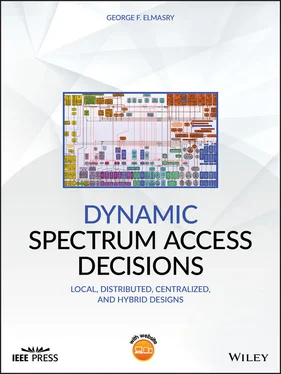1 Consider a hybrid DSA system you are designing with 10 mins minimum elapsed time before changing frequency assignment for a large‐scale set of heterogeneous networks. One of these heterogeneous networks has distributed agents in its nodes that make DSA decisions for the network and these decisions can take up to 200 ms due to spectrum sensing information propagation time and processing time. If you are asked to come up with a minimum time interval for a local agent to make a local DSA decision (time elapse after making a local DSA decision before you can consider making another one), which of the following time intervals would you choose?200 ms100 ms20 msExplain the reason for your choice.
2 In a hybrid DSA system, would you want a local DSA decision (e.g., power increase) to be propagated to peer agents that make distributed decisions? Explain your reason.
3 You are given a set of heterogeneous wireless networks with one network that operates at a narrowband of 100 kbps. Your analysis of DSA shows that DSA control traffic (e.g., spectrum sensing information and other DSA configuration parameters) would use about 30 kbps over this narrowband network. Would you proceed with your DSA design or consider assigning the narrowband network a fixed frequency band to operate at? Explain the reason for your choice.
1 Gandetto, M. and Regazzoni, C., Spectrum sensing: A distributed approach for cognitive terminals. IEEE Journal on Selected Areas of Communications, vol. 25, no. 3, pp. 546–557, April 2007.
2 Haykins, S., Cognitive radio: brain empowered wireless communications. IEEE Journal on Selected Areas in Communications, pp. 201–220, February 2005.
3 Hoffman, H., Ramachandra, H.P., Kovács, I.Z. et al., Potential of dynamic spectrum allocation in LTE macro networks. Advances in Radio Science Open Access Proceedings, vol. 13, pp. 95–102, 2015.
4 Hossain, E., Niyato, D. and Han, Z., Dynamic Spectrum Management in Cognitive Radio Networks. Cambridge University Press, 2009. ISBN: 978‐0‐521‐89847‐8.
5 Hu, R. and Qian, Y., An energy efficient and spectrum efficient wireless heterogeneous network framework for 5G systems. Proceedings of the IEEE Communications Magazine, vol. 52, issue 5, May 2014.
6 McHenry, M, Livsics, E., Nguyen, T., and Majumdar, N., XG dynamic spectrum sharing field test results. In Proceedings of the IEEE International Symposium on New Frontiers in Dynamic Spectrum Access Networks, Dublin, Ireland, April 2007, pp. 676–684.
7 Mitola, J., Cognitive Radio Architecture, in Cognitive Networks: Towards Self‐Aware Networks (ed. Q.H. Mahmoud). John Wiley & Sons, Chichester, 2007. doi: 10.1002/9780470515143.
8 Srinivasa, S. and Jafar, S., Cognitive radios for dynamic spectrum access – The throughput potential of cognitive radio: A theoretical perspective. IEEE Communications Magazine, vol. 45, issue 5, May 2007.
9 http://grouper.ieee.org/groups/dyspan/.
10 http://www.sharedspectrum.com/resources/darpa-next-generation-communications-program/.
11 https://www.wirelessinnovation.org/.
1 1 Part 4 of this book contains the DySPAN standards. DySPAN is selected over SAS in this book because it contains API design approaches that complement the goals of this book.
2 2There are different types of DSA services that can be offered in a set of DSA cloud services. Part 2 of this book shows that co‐site interference avoidance can be a collection of DSA services that incrementally increases the efficiency of frequencies assignments. The consideration of blanking signal, which ensures the accuracy of sensing information, can be another type of DSA service.
3 3DSA decisions are often needed when the radio frequency signal is compromised. The DSA control plane conditions may or may not be compromised at that time. When the DSA control plane is compromised, DSA services should be available. The response time between requesting a DSA service and granting the service should not be dependent on the DSA control plane conditions.
4 4 Some military networks can have an antijamming mode. A DSA decision can be switching from a high bandwidth normal mode to a lower bandwidth antijamming mode instead of changing the operating frequencies.
5 5 Order of time here means response time and the gap of time between two consecutive DSA service requests.
6 6Abstracting spectrum sensing information is covered in detail in Chapter 4.
Chapter 2 Spectrum Sensing Techniques
In order for a DSA wireless system to observe, orient, decide, and act as explained in the previous chapter, it must be aware of the spectrum sensing parameters and how they relate to the sensed frequency band characteristics. This chapter addresses the different spectrum sensing techniques that can be utilized. The spectrum sensing techniques covered in this chapter are presented in a generic way while pointing to which techniques can be implemented on specialized hardware and which techniques can be implemented as same‐channel for in‐band sensing. Notice that the focus of this chapter is not limited to spectrum sensing performed for a secondary user to use some spectrum bands opportunistically. As the previous chapter explained, there are many DSA cases in defense and commercial applications that go beyond the secondary user scope and are not necessarily in the cognitive radio domain. The focus of this chapter is also not limited to spectrum sensing techniques that can be developed for distributed cooperative MANETs. The spectrum sensing techniques explained here are generic and can be used for local decisions, distributed cooperative decisions, centralized decisions, or hybrid decisions, and for different types of communication systems.
2.1 Multidimensional Spectrum Sensing and Sharing
Spectrum sensing provides multidimensional spectrum usage characteristics over time, space, and frequency bands. Spectrum sensing can range from simple techniques such as measuring a signal energy or the SNIR, to learning about the types of signals occupying the frequency band while analyzing the signal specifics such as modulation techniques, utilized bandwidth, and carrier frequency. Naturally, the more complex the sensing techniques are, the more computationally intensive they are. One of the most important advantages of using specialized hardware for spectrum sensing is the ability to sense a wide band of frequencies through parallel processing of different segments of the sensed wideband spectrum. Specialized hardware can be built to process algorithms such as fast Fourier transformation (FFT) in real time.
There are different spectrum sensing techniques that are covered in this chapter. Notice that designing a system that utilizes spectrum sensing can mix and match any of the below techniques and shouldn't necessarily use a single sensing technique. Spectrum sensing techniques can include the following:
1 Time, frequency, and power sensing. This spectrum technique focuses on detecting the presence of signal energy on certain frequency bands based on factors such as time intervals and signal power measured within a frequency band.
2 Energy detection. 1This is the simplest and most commonly used spectrum sensing technique as it does not require prior knowledge of the signal being sensed. This technique simply measures the received signal power over a given sensing time. Energy detection can be used in conjunction with many of the other spectrum sensing techniques explained below. Some sensing techniques perform energy detection before exploring some of the signal characteristics explained below.
3 Signal characteristics. With this spectrum sensing technique, the sensor attempts to synthesize the sensed signal to find specific details about it. This spectrum sensing approach can start with technique such as:matched filter based spectrum sensingautocorrelation based spectrum sensing.After sensing a specific signal presence, the sensor can improve signal detection accuracy using signal characteristics based spectrum sensing such as:spreading code spectrum sensingfrequency hopping spectrum sensingorthogonality based spectrum sensing.With some known signals, the sensor can perform more signal‐specific spectrum sensing techniques such as:waveform based spectrum sensingcyclostationarity based spectrum sensing.
Читать дальше












